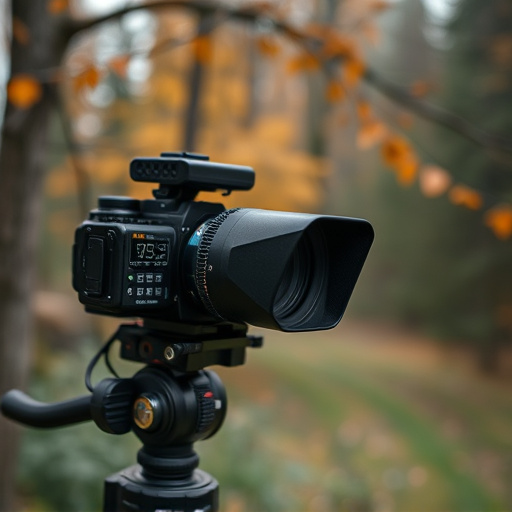Battery-powered covert nanny cameras rely on advanced glint detection technology to maintain clear image quality during nighttime surveillance, minimizing false signals from reflections. Using sophisticated algorithms, sensor technologies, and intelligent lighting management systems, these cameras balance energy conservation with robust glint identification, ensuring optimal performance without compromising discretion. By analyzing raw image data for sudden brightness changes, they accurately detect glints, providing continuous, high-quality surveillance around the clock. The development process involves gathering and analyzing diverse datasets, training machine learning models, and rigorous testing to optimize performance in real-world scenarios.
“Unveiling the secrets of night-time surveillance, this article delves into the intricate world of camera lens glint detection. With the rise in popularity of battery-powered covert nanny cameras, a unique challenge arises—capturing clear images without revealing their presence. We explore effective nighttime glint detection techniques tailored for these discrete devices.
From understanding the basic principles to implementing and testing these methods, this guide offers insights into enhancing night vision capabilities, ensuring discreet and reliable surveillance.”
- Understanding Glint Detection: The Basics
- Battery-Powered Covert Cameras: A Unique Challenge
- Nighttime Glint Detection Techniques
- Implementation and Testing Procedures
Understanding Glint Detection: The Basics
Glint detection is a crucial feature in night vision imaging, especially for covert surveillance using battery-powered nanny cameras. It refers to the process of identifying and minimizing unwanted reflections from surfaces like glass or metal, which can obscure the intended target. These reflections, known as glints, are caused by light bouncing off these surfaces, creating false signals that can degrade image quality.
In the context of covert operations, where discretion is paramount, understanding glint detection becomes essential. Battery-powered cameras, often used in domestic settings, might be subject to various environmental lights, including moonlight or street lighting, which can contribute to glints. Advanced algorithms and sensor technologies are employed to analyze real-time video feeds, distinguishing between true object reflections and false glints. This ensures that the camera captures clear images of subjects, maintaining the integrity of surveillance data without drawing unnecessary attention.
Battery-Powered Covert Cameras: A Unique Challenge
Battery-powered covert nanny cameras present a unique challenge in glint detection during nighttime operations. Unlike their wired counterparts, these devices operate independently, often relying on internal batteries for power and hidden placement to monitor activities discreetly. However, this autonomy introduces an additional layer of complexity when attempting to detect and minimize lens glints—the reflection of light that can reveal the presence of a camera, compromising its covert operation.
The challenge lies in balancing energy conservation while ensuring robust glint detection capabilities. Battery-powered cameras must conserve power for extended monitoring periods, making continuous, high-intensity lighting impractical. As such, innovative methods are required to detect glints without significantly draining batteries or sacrificing image quality. Effective strategies involve advanced sensor technology, sophisticated algorithms, and intelligent lighting management systems that can minimize lens glints while maintaining optimal surveillance conditions.
Nighttime Glint Detection Techniques
At night, glint detection becomes even more crucial for effective surveillance, especially with Battery Powered Covert Nanny Cameras. Advanced techniques leverage low-light conditions to capture subtle reflections from objects like windows and shiny surfaces. These methods often employ specialized sensors and algorithms that can distinguish between natural light sources and the occasional glint, minimizing false alarms.
One common approach is to analyze the camera’s raw image data, looking for sudden changes in brightness or unusual patterns that could indicate a glint. This process requires sophisticated signal processing algorithms designed to recognize these subtle variations without being triggered by normal night-time environmental changes. Battery Powered Covert Nanny Cameras, with their discreet nature and consistent power supply, play a vital role in facilitating these advanced glint detection techniques, ensuring round-the-clock surveillance without compromising on quality or accuracy.
Implementation and Testing Procedures
The implementation of glint detection in night-time surveillance systems, particularly with Battery Powered Covert Nanny Cameras, involves a meticulous process. Engineers and developers begin by capturing a vast dataset of various scenes under low-light conditions, including different surfaces and environments. This data is then meticulously analyzed to train machine learning models capable of identifying subtle glints. The models are fed images containing both glinted and non-glinted scenarios, allowing them to learn the patterns and features that define these reflections.
Testing procedures are rigorous and multifaceted. Camera lenses are exposed to simulated environments, mimicking real-world conditions, to ensure accurate detection. This includes testing in diverse weather, from heavy rain to foggy conditions, to verify the system’s robustness. Additionally, blind tests involving human evaluators are conducted to assess the model’s performance against glints caused by natural sources like moonlight or streetlights. These procedures are crucial for fine-tuning the algorithm and ensuring its reliability in real-world applications of Battery Powered Covert Nanny Cameras.
In addressing the challenge of detecting glints from Battery-Powered Covert Nanny Cameras in low-light conditions, this article has explored essential techniques and procedures. By delving into understanding glint detection, examining unique challenges posed by covert cameras, and implementing robust nighttime detection methods, we’ve highlighted effective strategies for successful surveillance. These tactics enable enhanced security, ensuring that even subtle glints are captured, making night-time monitoring more accurate and reliable.
